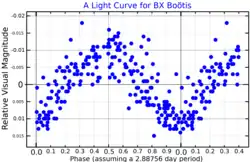| Observation data Epoch J2000 Equinox J2000 | |
|---|---|
| Constellation | Boötes |
| Right ascension | 15h 42m 50.760818s[2] |
| Declination | +52° 21′ 39.2444″[2] |
| Apparent magnitude (V) | 6.33 to 6.41[3] |
| Characteristics | |
| Spectral type | A0 Vsp SiSrCr[4] or B9 Vp SiCrSr[5] |
| B−V color index | −0.099±0.004[6] |
| Variable type | α2 CVn[7] |
| Astrometry | |
| Radial velocity (Rv) | −10.7±1.8[8] km/s |
| Proper motion (μ) | RA: −66.214[2] mas/yr Dec.: −29.308[2] mas/yr |
| Parallax (π) | 10.8059 ± 0.0811 mas[2] |
| Distance | 302 ± 2 ly (92.5 ± 0.7 pc) |
| Absolute magnitude (MV) | 0.21[6] |
| Details | |
| Mass | 2.70±0.09[9] M☉ |
| Radius | 2.51[10] R☉ |
| Luminosity | 72.4+10.8 −12.1[9] L☉ |
| Surface gravity (log g) | 4.50[11] cgs |
| Temperature | 9,164[11] K |
| Metallicity [Fe/H] | +0.63[11] dex |
| Rotation | 2.88756 d[1] |
| Rotational velocity (v sin i) | 30[12] km/s |
| Age | 235[13] Myr |
| Other designations | |
| Database references | |
| SIMBAD | data |
BX Boötis is a star in the northern constellation of Boötes. It is a dim star near the lower limit of visibility to the naked eye, having a nominal apparent visual magnitude of 6.35.[10] Based upon an annual parallax shift of 10.81 mas,[2] it is located 302 light years away. At that distance, the visual magnitude of the star is diminished by an extinction of 0.13 due to interstellar dust.[13] It is moving closer with a heliocentric radial velocity of −11 km/s.[8]
This is a magnetic CP star[1] with a stellar classification of A0 Vsp SiSrCr,[4] indicating this is an A-type main-sequence star. The spectrum has very weak lines of helium but displays strong overabundances of silicon and all of the heavier elements except nickel.[15] It is classified as an Alpha² Canum Venaticorum variable[7] with a magnitude that varies from 6.33 to 6.41[3] over a period of 2.88756 days.[1]
BX Boötis is 235[13] million years old with a projected rotational velocity of 30[12] km/s. It has 2.7[9] times the mass of the Sun and 2.5[10] times the Sun's radius. The star is radiating around 72[9] times the Sun's luminosity from its photosphere at an effective temperature of 9,164 K.[11]
References
- 1 2 3 4 Adelman, Saul J. (June 2008), "FCAPT uvby Photometry of the mCP Stars HR 1297, 25 Sex, BX Boo, and 49 Her", Publications of the Astronomical Society of the Pacific, 120 (868): 595–601, Bibcode:2008PASP..120..595A, doi:10.1086/588680, S2CID 122107251.
- 1 2 3 4 5 6 Brown, A. G. A.; et al. (Gaia collaboration) (August 2018). "Gaia Data Release 2: Summary of the contents and survey properties". Astronomy & Astrophysics. 616. A1. arXiv:1804.09365. Bibcode:2018A&A...616A...1G. doi:10.1051/0004-6361/201833051.
- 1 2 Watson, Christopher (January 4, 2010), "BX Boötis", AAVSO Website, American Association of Variable Star Observers, retrieved 5 August 2014.
- 1 2 Abt, H. A.; Cardona, O. (1984), "The nature of the visual companions of AP and AM stars", Astrophysical Journal, 276: 266, Bibcode:1984ApJ...276..266A, doi:10.1086/161610.
- ↑ Cowley, A.; et al. (April 1969), "A study of the bright A stars. I. A catalogue of spectral classifications", Astronomical Journal, 74: 375–406, Bibcode:1969AJ.....74..375C, doi:10.1086/110819.
- 1 2 Anderson, E.; Francis, Ch. (2012), "XHIP: An extended hipparcos compilation", Astronomy Letters, 38 (5): 331, arXiv:1108.4971, Bibcode:2012AstL...38..331A, doi:10.1134/S1063773712050015, S2CID 119257644.
- 1 2 Samus', N. N; Kazarovets, E. V; Durlevich, O. V; Kireeva, N. N; Pastukhova, E. N (2017), "General catalogue of variable stars: Version GCVS 5.1", Astronomy Reports, 61 (1): 80–88, Bibcode:2017ARep...61...80S, doi:10.1134/S1063772917010085, S2CID 125853869.
- 1 2 de Bruijne, J. H. J.; Eilers, A.-C. (October 2012), "Radial velocities for the HIPPARCOS-Gaia Hundred-Thousand-Proper-Motion project", Astronomy & Astrophysics, 546: 14, arXiv:1208.3048, Bibcode:2012A&A...546A..61D, doi:10.1051/0004-6361/201219219, S2CID 59451347, A61.
- 1 2 3 4 Kochukhov, O.; Bagnulo, S. (2006), "Evolutionary state of magnetic chemically peculiar stars", Astronomy and Astrophysics, 450 (2): 763, arXiv:astro-ph/0601461, Bibcode:2006A&A...450..763K, doi:10.1051/0004-6361:20054596, S2CID 18596834.
- 1 2 3 Shulyak, D.; et al. (September 2014), "Interferometry of chemically peculiar stars: theoretical predictions versus modern observing facilities", Monthly Notices of the Royal Astronomical Society, 443 (2): 1629–1642, arXiv:1406.6093, Bibcode:2014MNRAS.443.1629S, doi:10.1093/mnras/stu1259, S2CID 96452769.
- 1 2 3 4 Soubiran, C.; Le Campion, J.-F.; Cayrel de Strobel, G.; Caillo, A. (June 2010), "The PASTEL catalogue of stellar parameters", Astronomy and Astrophysics, 515: A111, arXiv:1004.1069, Bibcode:2010A&A...515A.111S, doi:10.1051/0004-6361/201014247, S2CID 118362423.
- 1 2 Strom, Stephen E.; et al. (2005), "B Star Rotational Velocities in h and χ Persei: A Probe of Initial Conditions during the Star Formation Epoch?", The Astronomical Journal, 129 (2): 809–828, arXiv:astro-ph/0410337, Bibcode:2005AJ....129..809S, doi:10.1086/426748, S2CID 15059129.
- 1 2 3 Gontcharov, G. A. (November 2012), "Spatial distribution and kinematics of OB stars", Astronomy Letters, 38 (11): 694–706, arXiv:1606.09028, Bibcode:2012AstL...38..694G, doi:10.1134/S1063773712110035, S2CID 119108982.
- ↑ "HD 46052". SIMBAD. Centre de données astronomiques de Strasbourg. Retrieved 22 August 2018.
- ↑ López-García, Z.; Adelman, S. J. (June 1999), "Elemental abundance studies of CP stars. II. The silicon stars HD 133029 and HD 192913", Astronomy and Astrophysics Supplement, 137 (2): 227–232, Bibcode:1999A&AS..137..227L, doi:10.1051/aas:1999247.
